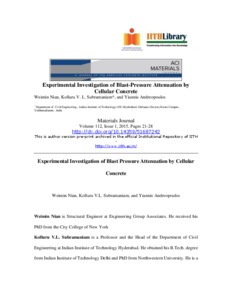Nian, W and K V L, Subramaniam and Andreopoulos, Y
(2015)
Experimental Investigation of Blast-Pressure Attenuation by Cellular Concrete.
Materials Journal, 112 (1).
pp. 21-28.
ISSN 0889-325X
![[img]](http://raiithold.iith.ac.in/1573/1.hassmallThumbnailVersion/1573_raiith_paper-final-M-2012-100.R1.pdf)  Preview |
|
Text (Author version post-print)
1573_raiith_paper-final-M-2012-100.R1.pdf
- Accepted Version
Download (1MB)
| Preview
|
Abstract
Results from an experimental investigation of the dynamic response of cellular concrete subjected to blast-pressure loading are presented. The cellular concrete has large entrained porosity in the form of uniformly distributed air cells in a matrix of hardened cement. Under quasi-static loading, once the applied stress exceeds the crushing strength of the cellular concrete, crushing and densification of material results in an upward concave stress-strain response. The shock-tube experimental test setup used for generating blast-pressure loading in a controlled manner is described. Experimental results from the cellular concrete subjected to blast-pressure loading with pressure amplitude greater than its crushing strength indicate that a compression stress wave, which produces compaction of the material due to collapse of the cellular structure, is produced in the material. As the compaction front propagates in the material, there is a continuous decrease in its amplitude. The impulse of the blast pressure wave is conserved. When a sufficient length of the cellular concrete is present, the applied blast pressure wave is completely attenuated to a rectangular stress pulse. The transmitted stress to a substrate from cellular concrete when an applied blast pressure wave is completely attenuated resembles a rectangular stress pulse of amplitude slightly higher than the crushing strength of the material with a duration predicted by the applied blast impulse.
Actions (login required)
 |
View Item |


 Altmetric
Altmetric Altmetric
Altmetric